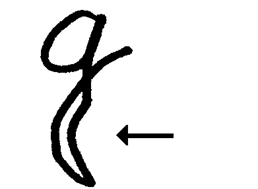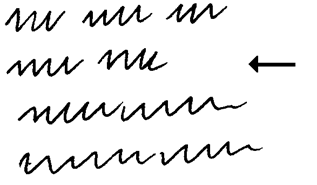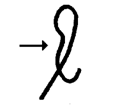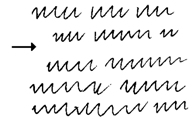
Free Article about Handwriting Analysis
From “Sunday Lessons III”
- Sunday Lesson #10: Directional Pressure
By Dr. Erika M. Karohs
As promised in Sunday Lesson #9, today you are learning about “Directional Pressure.” It is a concept that is unfamiliar to many analysts, yet it provides important insight into the personality of the writer. Especially the so-called “Felons’ Claw” occurs frequently and needs careful interpretation.
Directional Pressure
Directional pressure is not the type of pressure normally discussed in graphology. “It is an invisible pressure coming out of one of the four directions of the writing field, a pressure always of a negative nature and always having the effect of changing a straight downstroke into a curved one.”
Directional pressure does not cause a softly curved form. It results in a caved- in letter due to invisible pressure from either left, right, above or below.

The concept of the bent stroke is not new in graphology. It was used repeatedly in earlier literature. Roda Wiesermentions it in her investigation of the ductus, i. e., quality of the writing stroke. Wittlichand Pokornyclaim that bent strokes are always related to fear and mention them in the sense of the writers having experienced unusually severe traumatic events. They speak of Angeschlagensein (being wounded, being injured, and subsequently vulnerable).
Felix Klein’s theory of directional pressure
The late Felix Klein made the original observations leading to his theory during his incarceration in the concentration camps of Dachau and Buchenwald, Germany. He found that rigid people had the least chance of survival. One has to be resilient to endure such cruel circumstances. Klein also noted that the more flexible inmates showed a peculiar indication in their script, namely a curvature in the downstrokes toward the left.
Klein remembered that according to Pulver’steachings the right side connotes the future. He reasoned that having to deal with an overwhelming fear of tomorrow would manifest itself in writing and concluded that it had the effect of curving straight downstrokes toward the left.
Klein called this phenomenon directional pressure and explained that only flexible people showed directional pressure in their script.
The meaning of directional pressure
Directional pressure always pertains to the area or zone in which it occurs. It exposes strong fear within the writers and, at the same time, a special kind of resilience enabling them to cope with otherwise unbearable circumstances.
With directional pressure from the right, the writers are suffering trauma related to the future; they are experiencing fear of the father, or father figures, or fellow men in general. And while they are coping in some way or another, they basically have little hope that circumstances will change soon.
The writers may resort to the defenses of procrastination or withdrawal to reduce emotional strain. They may avoid commitments by dodging direct promises. They may withdraw from obligations, if possible, or try to postpone, hoping for a chance to get out of them. They act somewhat in the sense of what we have come to think of as survivors. They may try to outsmart others or profit from their gullibility. This is not done with deceitful intent but rather a maneuver to help them survive in the face of overwhelming threat. Whatever they do, living with unresolved fears takes a great toll both physically emotionally and mentally.
With directional pressure from the left, the writers have suffered trauma in the past that is still exerting a controlling influence in their lives. Unresolved fears from the past are affecting their behavior.
Directional pressure remains evident in people’s writing long after the traumatic events have passed and the emotional memory of the trauma stays with them indefinitely. It becomes reactivated by far less painful incidents. The person remains forever vulnerable and this is what Wittlich and Pokorny refer to when they speak of Angeschlagensein.
Directional pressure from the right can occur in any of the three zones and in the right margin. It indicates:
- fear or anxiety because of the future;

- possible difficulties with or pressure from the father;
- possible fear of fellow men.
Directional pressure in upper zone:

Directional pressure in middle zone

Directional pressure in the lower zone

Directional pressure in right margin

Directional pressure from the left can also occur in any of the three zones and in the left margin. It reveals:
- unresolved fears from the past, possibly influencing future decisions;

- maternal pressure.
Directional pressure in upper zone:

Directional pressure in middle zone

Directional pressure in lower zone

Directional pressure in the left margin

Directional pressure from above exposes:
- strain in the intellectual field, mostly because of beliefs;

- pressure from people who are considered superior in intelligence (avoidance of such people may be indicated).

These writer tend to adopts a more shallow approach to life. Shallowness, however, does not imply lack of intelligence. It does not pertain to the writer’s thinking ability but rather to the attitude toward his goals.
The shallow t-bar is a sign that the will has given way under pressure. He uses irresponsibility as emotional escape due to fear. He has adopted an attitude of ease or disinclination to exert will power toward a purpose, an indifference about getting or staying involved. He may be committed but not to the end.
The will gives way because the person does not have the mental energy or strength to follow through with his own goals or purposes. He may suddenly bail out of commitments he had previously assumed.
Frequency of the stroke is important. Occasionally, it means simply that the writer is abandoning some goal in favor of another. Or he may refuse to accept more responsibilities because he already has more than he can comfortably carry. Other indicators in the writing are important.
If the shallow t-bar is pervasive in the writing, you end up with a writer who is dancing to someone else’s tune.
Directional pressure from below signifies:
- strain due to influences from the body
- pressure due to influences from the sexual zone
- financial concerns
- aggravation from people of lower intelligence
- problems of every-day life

Directional pressure from below can take the form of the so-called “felon’s claw.”

The so-called “felon’s claw”
The felon claw suffers subconscious guilt for something that happened earlier in his life. He not only has a deep-seated feeling of wrongdoing but also a deeply ingrained need to be punished. His sense of shame creates an insidious, negative self-image that may or may not be conscious. Often these people have been made to feel guilty throughout their childhood and formative years whole life and the need to feel guilty has followed them into adulthood.
Ruiz-Amend state: “Subconsciously the writer feels that he needs a more tangible punishment than his own feelings of unworthiness can provide. He will relieve this need by provoking other people, often in a seemingly harmless way that results in direct confrontation or honest anger.”1
The writer can be touchy and defensive and in certain situations, he may try project his unconscious guilt on others. For instance, he may forget an appointment and then find a way to blame the supervisor by saying he did not specify a definite deadline. Subtly, his attitude says, “You made me do it.”
A classic maneuver by a felon’s claw writer is to silently display intimidating anger in every movement and pore of his body. Then, when the friend or relative responds in a cross way, he blame that person for starting it all.
By upsetting the other people and suffering their wrath some of the writer’s inner tension is relieved.
The writer often sabotages himself by creating a negative situation because he does not think he deserves a positive result. He feels he is not worthy of the good things that happen to him and, therefore, he subconsciously undermines positive things in his life. He may develop an undeserving kind of attitude. For instance, he may be may be absent from work the day promotions are given, or he may have an accident going to an interview. If he feels that he is not entitled to a career advance or even a compliment, he may subconsciously set up a situation where he appears in a bad light. In other words, he unconsciously sets himself up to fail. He may deliberately do something at work that will cause his superiors or co-workers to wonder why he was ever hired. He may accept a compliment in a way that no one wants to offer future compliments. Sooner or later, he can be counted on to provoke trouble.
These writers may try to get close to other people and eventually hurt them in some way. When the hurt individual gets angry, the writer’s need to feel guilty is satisfied.
Outwardly, these people may go out of their way to please. They may project such a sweet outer facade that people not close to them would find it hard to believe their troublesome behavior.
When the felon’s claw appears in the middle zone, on the letter d, or within capital letters, it is not as destructive a placement as the one that is seen in the lower zone. In the middle zone, the guilt implied by the stroke is conscious because it is above the baseline in the realm of everyday affairs. For example, the writer may being chronically late and apologize profusely. However, he will not change his aggravating behavior.
When found in the lower zone, the felon’s claw relates to unconscious guilt. It is often combined with an instinctual need on the writer’s part to draw unto himself, to take, to pounce upon those things that have been denied him. These things are likely to be in the emotional, financial, or physical survival areas, as the writer understands them.
The higher the claws rise, the greater is the significance of the stroke and the inclination toward dishonest or criminal tendencies.
A claw coming up from the lower zone and going above the baseline is a strong sign of dishonesty. It often appears often in graffiti and in the script of many convicted felons. (That is the reason for its name.)
In some instances, the felon claw writer seems to have his own way of achieving his negative aims. The writing seems to bear this out because the felon’s claw moves in the direction that is contrary to the school model.
Betty Link states that the arcade stroke that moves from right to reminds one of the unexpected pouncing movement of a cat as it grabs a mouse or some other object that it has previously pretended to ignore. As a backward arcade it suggests both an opposition to the normal ways of obtaining a desired object, and also a compensation to which he feels entitled.
The felon’s claw is almost never seen in the upper because the behavior must be acted out to be effective.
A felon’s claw on the ppI is a negative sign that usually spells trouble immediately. No matter what style the writing, there are guilty feelings that the writer must discharge. To accomplish this, he will provoke others needlessly and heedlessly in order to be punished. Amend: “Sometimes sweet, sometimes hostile, always annoying, often dangerous, this abrasive type exhibits negative and self-serving behavior by centering upon himself and his own needs. “
Directional pressure from the left and right
Wittlich interprets long strokes bent in two directions as the result of severe emotional shock in the person’s life. He calls it a rupture in the person’s sense of livingness, meaning his feeling for and appreciation of life altogether.

I hope that you will enjoy this lesson and that it will be informative to you.
Best regards,
Erika M. Karohs, Ph. D., Ed. D.
emkarohs@gmail.com
https://karohs.com
o Felix Klein, “Directional Pressure,” Graphologische Schriftenreihe, #6, 1967.
o Roda Wieser, Der Verbrecher und seine Handschrift (Stuttgart: Altdorfer Verlag, 1952).
o Bernhard Wittlich, Angewandte Graphologie (Berlin: Walter de Gruyter & Co., 1951).
o Richard Pokorny, Psychologie der Handschrift (München: Kindler Verlag, 1973).
o Max Pulver, Symbolik der Handschrift (Zürich, Orell Füssli Verlag, 1951).
See detail courses programs (click the image below):
Copyright © 2014 the KAROHS International School of Handwriting Analysis®. All rights reserved.
No image or portion of this website may be copied or reproduced without written permission.
The Master course replaces the Step-by-Step System of Handwriting Analysis
Important Notice: Prerequisite for enrollment in the Master course is successful completion of the Comprehensive Course.
The Master Course was designed with professionals in mind. It is for elite corps of dedicated analysts with the intelligence and curiosity to comprehend this unique system. It is for bright, intelligent individuals who are excited and enthused about delving as deeply as possible into graphology and who want to use the science in a businesslike and profitable way.
Master Course – The only integrated system
The Master course is the only course that integrates the trait stroke method with the following aspects of the Gestalt system:
- the contraction-release system originally expounded by Klages;
- Pulver’s theory of depth as an unconscious expression of the writer’s psychic and physical energy;
- Saudek’s thesis of writing speed as one of the foundations upon which other data rests.
The Master course is not alone in utilizing the above theories. They are incorporated to a greater or lesser degree in most contemporary graphological schools.
The Master course, however, combines all of these fundamental theories in one logical system.
The Master was inspired by the principles of Otto Junge’s “Rational Graphology” in that it is based upon objective measurements and ratings and assigns equal quantitative weight to each handwriting component.
The Master differs from Rational Graphology in that it is more systematically organized. Junge designed 100 “Expression Tables” and evaluated between ten and twenty variables for one personality trait. The various traits were grouped in five syndromes with the smallest syndrome containing five and the largest encompassing forty-two characteristics. The Master consistently evaluates ten components per trait. The traits are then grouped in eight syndromes of five traits each.
The Master is designed in a logical sequence so that by executing six steps the analyst automatically produces an accurate, objective analysis every time.
HOME
Click here to back to KAROHS Home Page
COURSE
Click here to see our Course Programs
BOOKS
Click here to see our Books Store
Copyright © 2018 the KAROHS International School of Handwriting Analysis®. All rights reserved.
No image or portion of this website may be copied or reproduced without written permission.







